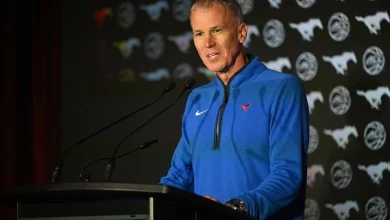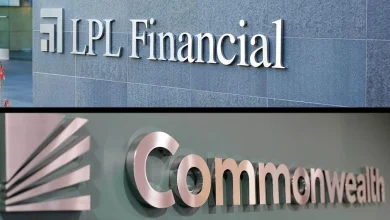Erling Haaland: The Borussia Dortmund years

When the first whistle blows at 8pm and Borussia Dortmund’s staff look at their watches, some might hold their gaze a little longer.
The timepieces staring back at them serve as a reminder of Wednesday’s opponent, Erling Haaland, a former son who left an indelible imprint on the German club during his two-and-a-half-year stay.
“In the last 20 years, I’ve worked with thousands of players, young and old, but he is one of the best in terms of respect,” says former Dortmund physio Thomas Zetzmann.
“In his last week, he gave everyone farewell gifts. We came into the gym and there were big tables with Rolex and Omega watches. Erl said: ‘Thank you very much, Zetzy, you’re the best’.
“Other great players left who were there much longer than Erl, but he showed his appreciation to everyone — and I won’t ever forget that.”
The gifts totalled more than €250,000 (£220,000; $290,000) and included junior chefs and those who performed what many may see as menial tasks. Many did not know how to react to such a gesture, as they were so overwhelmed that a player of his stature considered them important enough to make the cut.
One or two notable players had bought champagne as a parting gift but nothing this grand. As if to further prove how he valued them, each watch came with their names engraved and the date on it.
Before he left Dortmund for Manchester, he recorded a vlog with the club channel called ‘One last day with Erling’. “It’s going to be really sad tomorrow, I think I’m gonna cry,” he says as he prepares for his final match.
This is not Haaland’s first reunion. Manchester City met them in the group stage just four months after he made the £51million ($66m) move to England in the summer of 2022.
On that occasion, he arrived with a huge bag of signed shirts to give to the staff he had left behind. It further underlined how pivotal he considered this chapter of his career to be in catapulting him into the A-list.
Erling Haaland celebrates scoring for Dortmund in May 2022 (Ina Fassbender/AFP via Getty Images)
Emerging from Norway, Haaland did not have the luxury of a top-level domestic league to prepare him for the jump to the very elite. His career path had to be carefully progressed but, after leaving Molde for Austrian champions Red Bull Salzburg in 2019, he was ready to level up within just six months.
While all of Europe’s top clubs pursued him, some had reservations about whether he could replicate his 29 goals in 27 appearances at a higher level. Dortmund were convinced that they were witnessing European football’s next elite striker.
They met his £17.1m buyout clause and, despite not expecting to sign that day, Haaland put pen to paper in late December after extensive talks.
He arrived as part of a young squad managed by Lucien Favre, a then-62-year-old Swiss who is said to always find a fault with any player — no matter how talented they were.
At Borussia Monchengladbach in 2012, it was the signing of 19-year-old Granit Xhaka from Basel that he bemoaned. So, when another teenager in Haaland arrived with a knee issue and no set date on when he would be able to play, there was some frustration.
Cue a 17-minute demolition of Augsburg as Haaland scored a hat-trick and turned a looming 3-1 defeat into a rousing 5-3 victory.
Haaland with then-Dortmund manager Lucien Favre in 2020 (Friedemann Vogel – Pool/Getty Images)
He became the seventh Bundesliga debutant to score three goals, but he was the first to do so from the bench, coming on at 56 minutes into the game. The only person to score a hat-trick in the German top flight at a younger age was Eintracht Frankfurt’s Walter Bechtold (18) in 1965 — seven years before Haaland’s father Alf-Inge was born.
In German football culture, however, it is not considered a true hat-trick if someone else breaks the chain in between, but Jadon Sancho’s goal did not stop Haaland from taking the match ball home with him.
It was a dream start. There was a romantic element too, because former Dortmund striker Pierre-Emerick Aubameyang had been the last player to score a hat-trick on his Bundesliga debut, the very player who inspired Haaland to choose the No 17 jersey.
The records continued to tumble. He became the first and only Dortmund player to score on his debut in the Bundesliga, the DFB-Pokal (German Cup) and the Champions League. He even scored in his German Super Cup debut against Bayern Munich.
Suddenly, the six-year-centre-forward itch created by Robert Lewandowski’s switch to Bayern Munich in 2014 had been scratched. Haaland scored quicker than his Polish counterpart — 86 goals at a rate of one every 84 minutes compared to 103 strikes at a rate of one every 139 minutes — during his time, but his personality was just as potent.
He was close with English duo Sancho and Jude Bellingham, but was already mature beyond his years, which allowed him to become a big character within the group.
He was unafraid to turn up for training in lurid clothes and did not care if he was the butt of the joke. Sporting director Michael Zorc would make a game out of how much pasta the striker could possibly fit on the one plate, and he was often seen leaving training crunching on a raw carrot, Bugs Bunny style.
Haaland with Jadon Sancho and the DFB-Pokal in 2021 (Martin Rose/Getty Images)
There was still some baby fat on his face when he arrived in Germany, but by the time he left, he was a fully-fledged superstar. As that transition happened, he was less accommodating with media obligations and on a couple of occasions, gave abrupt answers to what were admittedly closed questions.
“Hard shell, soft core” is the phrase a former colleague at Dortmund uses to describe the blend of ultra-human and ultra-robot traits that saw him make such an outsized impact on and off the pitch.
At Dortmund, they likened the privilege — and challenge — of overseeing Haaland’s development from boy to man to building a racing car.
They had the best parts, but it required top engineering and maintenance to boot. That final part proved difficult at times in a major league: he had to perform at full throttle every few days. There were new demands on his young body compared to Salzburg, where they were the dominant club in a league of varied quality.
“When Erling came to Dortmund as a young player, his body wasn’t so good. He was very hard on himself, but he was already like Hercules. Made of steel,” says Zetzmann.
Dortmund had five physios at the time but Haaland took a shine to Zetzmann and asked for him to come on family vacations at times to ensure he was looking after his body correctly.
It included a week spent in the searing heat of Marbella, working on a troublesome hamstring. But while Haaland thought the solution was to train more, he was encouraged to tone down his approach.
“He wanted to be in the gym morning, afternoon and night. I had to tell him it wasn’t so good for him,” says Zetzmann.
“When you told him, he was like ‘No, no, I can do it’. But you could talk with him, and the next day he would say, ‘OK, you are right. He is not the Terminator and he needed time for regeneration.
“I said to him, ‘When you are close to 30, you can do more, but one day you must rest. Go to the sauna or cinema or play PlayStation’. All week, he came back to say, ‘Training, training’. He had such great energy for the game and trained like he was a machine.”
Haaland’s commitment to training has never been in doubt (Alex Grimm/Getty Images)
That single-mindedness showed itself in his first season when he scored four times in a Friday night game at Hertha Berlin and was visibly angry with Favre about being taken off with minutes to go.
Danish midfielder Thomas Delaney once said the only thing Haaland does in life is watch football. He does not have a life outside of it. He either plays FIFA/EA FC or real-life football.
It is that obsession that fuelled his rapid development at Dortmund. When he would be travelling to away matches on the plane, it was common to see him studying the intricate details of other great goalscorers, mining the footage for patterns of when they look at the goalkeeper and which finish they use at various angles.
Rene Maric, who was Marco Rose’s assistant at Dortmund from 2021-22 and now works with Vincent Kompany at Bayern Munich, believed Haaland could score more headers. He worked on that while Alexander Zickler spent time improving his weaker right foot.
“He was never satisfied,” says RB Leipzig fitness coach Patrick Eibenberger, who worked with Haaland at Salzburg and Dortmund.
Haaland was only 18 when he met Eibenberger, but he was so tall that part of the room went dark when he walked in due to how much of the light he covered.
“He was the complete package. He was unlimited,” says his former coach. “He was extremely gifted physically in how flexible he is for a guy of his body size. You could see the shell and, in combination with his mindset, you knew he had the potential.
“But then I remember the time he rocketed at Salzburg when he scored a hat-trick on his Champions League debut. That’s when I thought, ‘Holy s***, this guy can be really, really big’.”
Haaland was not overly vocal. He did not speak too much about what he wanted; he just showed it. He had a plan in his head and he wanted to roll it out as quickly as possible.
If he was to make the step up to the very elite, he wanted to maximise his natural strengths and that meant adding a few extra kilograms of muscle while also pushing the limits of his pace and explosiveness. There could be no compromise.
“What’s different from other very talented guys is that he didn’t need any confirmation from anyone else,” says Eibenberger.
“He measured himself to his own standards. He was very locked into that process, so it was easy to plan a roadmap. On the grass, it was about finding the drills to see if he was getting quicker, as he always wanted to see if he was improving. We would show him the numbers and micromanage the extra work he would do.”
Haaland celebrates against Leipzig in 2021 (Filip Singer – Pool/Getty Images)
Like many top players, Haaland started employing his own fitness team at Dortmund in an attempt to find an extra edge. He missed 16 games in his final season due to injury and much of the work was focused on relieving tension on his knees, ankles, joints, and the muscles surrounding them. They worked on his biomechanics and trained his hip alignment to cause less strain on his body.
Familiar faces in the opposition will be in short supply for Haaland in Manchester on Wednesday. Goalkeeper Gregor Kobel, Emre Can and Julian Brandt are the only survivors from his time at the club.
He knows as well as anyone how quickly squads evolve at Dortmund. They have become a pit stop for some of the best young talents in football but it has meant that instability — the auctioning of their best individuals before they can grow as a team — has limited their ability to challenge Bayern Munich over the last decade.
He produced the numbers of a winning team, but a DFB-Pokal win in his first season — the Norwegian scored a double in the 4-1 win over Leipzig — was the only trophy he claimed. They recorded a third-place finish and earned two runners-up spots.
There were plenty of memorable goals along the way. A double at home against Paris Saint-Germain in the Champions League, which saw him rifle in a spectacular 25-yard strike and curl home from a position almost in line with the goal post, looked so simple.
Before the meeting with his former club, Haaland was asked if he had his sights set on breaking some of his own goalscoring records.
“Not to sound arrogant… but which one?” he replied. That about sums up the monster that Dortmund helped create, and now have to try to stop.





